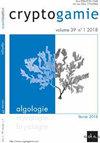Mallomonas skogstadii sp. nov. and M. bakeri sp. nov.: Two New Fossil Species from the Middle Eocene Representing Extinct Members of the Section Heterospinae?
IF 1.5
4区 生物学
Q3 MARINE & FRESHWATER BIOLOGY
引用次数: 4
Abstract
Abstract Two new fossil species of the synurophyte genus Mallomonas, M. skogstadii and M. bakeri, are described from Giraffe Pipe, an Eocene locality situated near the Arctic Circle in northern Canada. Scales of both new species share a suite of characters, including an oval-shaped rib encircling approximately half of the base plate and most of the dome, a series of thick ribs on the posterior flange, but lacking on the shield, a thin posterior rim, and a flat and shallow dome. In addition, both species possess two types of scales, body scales and apical scales. Apical scales of M. bakeri form a unique forward–projecting dome, and those of M. skogstadii are significantly different in shape than the body scales. Scales of M. skogstadii are significantly larger and have a different base plate pore pattern than those of M. bakeri, and remains of both taxa were uncovered in strata deposited hundreds of years apart. Based on comparison made with modern species, M. bakeri, and to a lesser extent M. skogstadii, are placed into, and likely represent basal representatives of section Heterospinae. The floras associated with each species reflect acidic environments, probably high in dissolved humic content.malomonas skogstadii sp. 11和m.b akeri sp. nov.:中始新世的两个新化石种,代表异ospinae剖面已灭绝的成员?
摘要/ Abstract摘要:在加拿大北部靠近北极圈的始新世长颈鹿管(Giraffe Pipe)地区发现了两个新的伴泌尿植物Mallomonas属的化石种M. skogstadii和M. bakeri。这两个新物种的鳞片都有一套共同的特征,包括一个椭圆形的肋骨环绕着大约一半的底板和大部分的圆顶,在后翼缘上有一系列厚的肋骨,但在盾上没有,一个薄的后缘,和一个平坦而浅的圆顶。此外,这两个物种都有两种类型的鳞片,体鳞片和顶鳞片。白僵菌的顶鳞片呈独特的前凸圆顶状,而白僵菌的顶鳞片与体鳞片在形状上存在显著差异。skogstadii的鳞片比M. bakeri的鳞片更大,基板孔隙模式也不同,并且在相隔数百年的地层中发现了这两个分类群的遗骸。根据与现代种的比较,M. bakeri和M. skogstadii在较小程度上属于异棘科的基部代表。与每个物种相关的植物区系反映了酸性环境,可能是高溶解腐殖质含量。
本文章由计算机程序翻译,如有差异,请以英文原文为准。
求助全文
约1分钟内获得全文
求助全文
来源期刊

Cryptogamie Algologie
生物-海洋与淡水生物学
CiteScore
2.60
自引率
7.70%
发文量
11
审稿时长
>12 weeks
期刊介绍:
Cryptogamie is a fast-track and peer-reviewed journal of international scope publishing in English only. It accepts original papers and review articles on the taxonomy, biology and ecology of all cryptogams. An issue of Cryptogamie may be devoted to a single topic, under the responsibility of guest editor(s). All articles published in Cryptogamie are compliant with the different nomenclatural codes. A copyright assignment will be signed by the authors before publication.
Cryptogamie, Algologie accepts articles on systematics as well as ecology and evolution of any kind of algae (including Cyanobacteria).
 求助内容:
求助内容: 应助结果提醒方式:
应助结果提醒方式:


